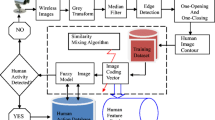Abstract
Human–Animal Conflict (HAC) is one of the primary threats to the continued survival of animal species and it has also impacted the lives of humans drastically. In this paper, we propose an efficient animal detection and recognition system with invariant features and fuzzy logic using thermal images. The proposed system exploits various features like Zernike, shape, texture and skeleton path. Cumulatively, these features are invariant to rotation, scaling, translation, illumination, and partly posture. The proposed model is robust to several challenging image conditions like low contrast/illumination, haze/blur, occlusion, camouflage, background clutter, and poses variation. The model is tested on our thermal animal dataset that has 1862 images and 12 different animal species. Experimental results validate the significance of thermal images for animal-based applications. Besides, the proposed fuzzy system has achieved an average accuracy of 97% which is equivalent to the accuracy produced by domain experts in identifying the animals from our thermal dataset.














Similar content being viewed by others
Explore related subjects
Discover the latest articles and news from researchers in related subjects, suggested using machine learning.References
Ganow, K.B., Caire, W., Matlack, R.S.: Use of thermal imaging to estimate the population sizes of Brazilian free-tailed bat, Tadarida Brasiliensis, maternity roosts in Oklahoma. Southwestern Nat. 60(1), 90–96 (2015). https://doi.org/10.1894/SWNAT-D-14-00010R1.1
Hristov, N.I., Betke, M., Theriault, D.E., Bagchi, A., Kunz, T.H.: Seasonal variation in colony size of Brazilian free-tailed bats at Carlsbad Cavern based on thermal imaging. J. Mammal. 91(1), 183–192 (2010). https://doi.org/10.1644/08-MAMM-A-391R.1
Welbourne, D.U.S.T.E.N.: A method for surveying diurnal terrestrial reptiles with passive infrared automatically triggered cameras. PLoS ONE 6, e18965 (2013)
Goodenough, A.E., Carpenter, W.S., MacTavish, L., MacTavish, D., Theron, C., Hart, A.G.: Empirically testing the effectiveness of thermal imaging as a tool for identification of large mammals in the African bushveldt. Afr. J. Ecol. 56(1), 51–62 (2018). https://doi.org/10.1111/aje.12416
Barbosa Pereira, C., Kunczik, J., Zieglowski, L., Tolba, R., Abdelrahman, A., Zechner, D., Czaplik, M.: Remote welfare monitoring of rodents using thermal imaging. Sensors 18(11), 3653 (2018). https://doi.org/10.3390/s18113653
Zhou, D., Dillon, M., Kwon, E.: Tracking-based deer vehicle collision detection using thermal imaging. In: 2009 IEEE International Conference on Robotics and Biomimetics (ROBIO) (pp. 688–693). IEEE. (2009) https://doi.org/10.1109/robio.2009.5420589
Zhou, D., Wang, J., Wang, S.: Contour based HOG deer detection in thermal images for traffic safety. In: Proceedings of the International Conference on Image Processing, Computer Vision, and Pattern Recognition (IPCV) (p. 1). The steering committee of the world congress in computer science, computer engineering and applied computing (WorldComp) (2012)
Cilulko, J., Janiszewski, P., Bogdaszewski, M., Szczygielska, E.: Infrared thermal imaging in studies of wild animals. Eur. J. Wildl. Res. 59(1), 17–23 (2013). https://doi.org/10.1007/s10344-012-0688-1
Forslund, D., Bjärkefur, J.: Night vision animal detection. In: 2014 IEEE intelligent vehicles symposium proceedings (pp. 737–742). IEEE. (2014) https://doi.org/10.1109/ivs.2014.6856446
Roy, S., Shivakumara, P., Jain, N., Khare, V., Dutta, A., Pal, U., Lu, T.: Rough-fuzzy based scene categorization for text detection and recognition in video. Pattern Recogn. 80, 64–82 (2018). https://doi.org/10.1016/j.patcog.2018.02.014
Darwich, A., Hébert, P.A., Bigand, A., Mohanna, Y.: Background subtraction based on a new fuzzy mixture of Gaussians for moving object detection. J. Imaging 4(7), 92 (2018). https://doi.org/10.3390/jimaging4070092
Mahapatra, A., Mishra, T. K., Sa, P. K., Majhi, B.: Background subtraction and human detection in outdoor videos using fuzzy logic. In: 2013 IEEE international conference on fuzzy systems (FUZZIEEE) (pp. 1–7). IEEE. (2013) https://doi.org/10.1109/fuzz-ieee.2013.6622397
Toran, V., Sipi, D.: Fuzzy-filtered neural network for rice disease diagnosis using image analysis. Int. J. Innov. Technol. Explor. Eng. 8, 437–446 (2019)
Brunassi, L.D.A., Moura, D.J.D., Nääs, I.D.A., Vale, M.M.D., Souza, S.R.L.D., Lima, K.A.O.D., et al.: Improving detection of dairy cow estrus using fuzzy logic. Scientia Agricola 67(5), 503–509 (2010). https://doi.org/10.1590/S0103-90162010000500002
John, V., Mita, S., Liu, Z., Qi, B.: . Pedestrian detection in thermal images using adaptive fuzzy C-means clustering and convolutional neural networks. In: 2015 14th IAPR international conference on machine vision applications (MVA) (pp. 246–249). IEEE. (2015) https://doi.org/10.1109/mva.2015.7153177
Kang, J.K., Hong, H.G., Park, K.R.: Pedestrian detection based on adaptive selection of visible light or far-infrared light camera image by fuzzy inference system and convolutional neural network-based verification. Sensors 17(7), 1598 (2017). https://doi.org/10.3390/s17071598
Jain, I., Rani, B.: Vehicle detection using image processing and fuzzy logic. Int. J. Comput. Sci. Commun. 1(2), 255–257 (2010)
Meena, S.D., Agilandeeswari, L.: Stacked convolutional autoencoder for detecting animal images in cluttered scenes with a novel feature extraction framework. Soft computing for problem solving, pp. 513–522. Springer, Singapore (2020). https://doi.org/10.1007/978-981-15-0184-5_44
Stubendek, A., Karacs, K.: Shape recognition based on projected edges and global statistical features. Math Prob Eng (2018). https://doi.org/10.1155/2018/4763050
F. systems. Thermal imaging, night vision and infrared camera system. https://www.flir.com. Accessed 3 Jan 2019
Meena, S.D., Agilandeeswari, L.: An Efficient framework for animal breeds classification using semi-supervised learning and Multi-Part Convolutional Neural Network (MP-CNN). IEEE Access 7, 151783–151802 (2019). https://doi.org/10.1109/ACCESS.2019.2947717
Meena, S.D., Agilandeeswari, L.: Adaboost cascade classifier for classification and identification of wild animals using movidius neural compute stick. Int. J. Eng. Adv. Technol. 9(13), 495–499 (2019). https://doi.org/10.35940/ijeat.a1089.1291s319
Sun, K., Mou, S., Qiu, J., Wang, T., Gao, H.: Adaptive fuzzy control for non-triangular structural stochastic switched nonlinear systems with full state constraints. IEEE T Fuzzy Syst 27, 1587–1601 (2018). https://doi.org/10.1109/TFUZZ.2018.2883374
Sun, K., Qiu, J., Karimi, H.R., Gao, H.: A novel FiniteTime control for nonstrict feedback saturated nonlinear systems with tracking error constraint. IEEE Trans. Syst. Man Cybern. Syst. (2019). https://doi.org/10.1109/tsmc.2019.2958072
Divya, M.S., Agilandeeswari, L.: A new supervised clustering framework using multi discriminative parts and expectation–maximization approach for a fine-grained animal breed classification (SC-MPEM). Neural Process. Lett. (2020). https://doi.org/10.1007/s11063-020-10246-3
Divya, M.S., Agilandeeswari, L.: FSSCaps-DetCountNet: fuzzy soft sets and CapsNet-based detection and counting network for monitoring animals from aerial images. J. Appl. Remote Sens. 14(2), 026521 (2020). https://doi.org/10.1117/1.JRS.14.026521
Acknowledgements
The authors thank VIT for providing ‘VIT SEED GRANT’ to carry out this research work.
Author information
Authors and Affiliations
Corresponding author
Rights and permissions
About this article
Cite this article
Meena, D., Agilandeeswari, L. Invariant Features-Based Fuzzy Inference System for Animal Detection and Recognition Using Thermal Images. Int. J. Fuzzy Syst. 22, 1868–1879 (2020). https://doi.org/10.1007/s40815-020-00907-9
Received:
Revised:
Accepted:
Published:
Issue Date:
DOI: https://doi.org/10.1007/s40815-020-00907-9




